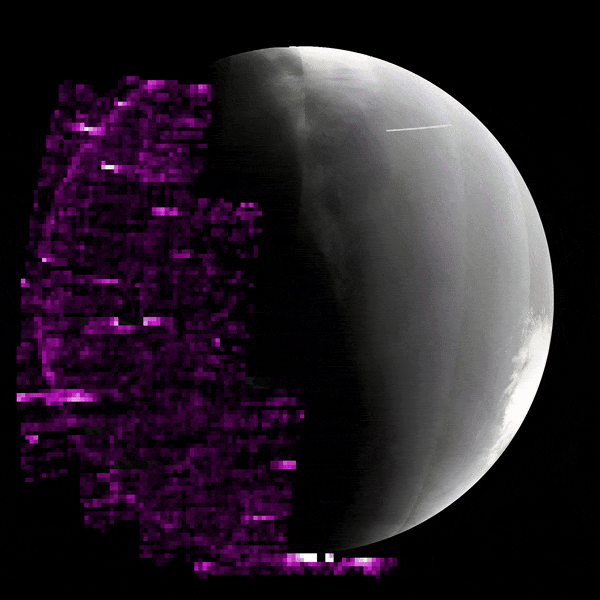Solar System
NASA's Curiosity Rover Accidentally Discovers Sulfur Crystals on Mars
The rover’s wheel cracked open a rock and revealed pure elemental sulfur, which researchers have never seen on the Red Planet before
How to Watch the Southern Delta Aquariids Meteor Shower
Though not as prolific as the Perseids, this annual spectacle is 'scientifically interesting' because its comet of origin remains a mystery
Astronomers Propose New Criteria to Classify Planets, but Pluto Still Doesn't Make the Cut
The new definition would define planets based on mass, rather than more ambiguous shape and size characteristics
Two Massive Asteroids Will Fly Past Earth This Week. Here's What to Know
Within 42 hours of each other, the pair of large asteroids, which both have no chance of impacting our planet, will approach Earth as they orbit the sun
Jupiter's Signature Red Spot May Have Evolved More Than Once
The planet's massive storm, known as the Great Red Spot, seems to be different from a spot first observed at roughly the same location in the 17th century, a new study finds
After Months of Glitches and Gradual Fixes, Voyager 1 Is Fully Operational Once Again
Currently 15 billion miles away from Earth, one of NASA’s longest-tenured spacecraft is back from the brink after a technical failure last year put its future in question
Mars Was Hit With a Solar Storm Days After Earth's Aurora Light Show, NASA Says
Studying this event could hold lessons for scientists about how to protect astronauts from radiation on future trips to the Red Planet
A Giant Interstellar Cloud May Have Once Enveloped Earth, Potentially Causing Ice Ages
Astronomers suggest this cold, dense cloud compressed our sun's protective field between two and three million years ago, leaving the Earth exposed to cosmic material
Astronomers Discover Water Frost on Mars' Tallest Volcanoes
On early winter mornings, a thin layer of ice forms in craters atop the Red Planet's towering peaks, near its equator, according to a new study
Missed the Auroras in May? Here’s How to See Them Next Time
Three veteran aurora chasers and a NASA scientist share everything you need to know to check these dazzling displays off your bucket list
Missed the 'Parade of Planets'? These Upcoming Alignments Will Likely Be Better, Anyway
Astronomers tempered expectations of the celestial event this week, pointing to others in the near future as more exciting opportunities for sky watchers
Venus Might Still Have Active Volcanoes, as Recent Lava Flows Suggest 'Ongoing' Eruptions
Astronomers have again discovered evidence of recent volcanic activity on Earth's sister planet in data from the 1990s
Researchers Trace the Origin of the Sun's Magnetic Field, Shedding Light on Space Weather and Solar Cycles
In a new study, scientists suggest the sun's magnetic field originates much closer to the star's surface than previously thought, a finding that could boost predictions of solar activity
The Seven Most Amazing Discoveries We’ve Made by Exploring Jupiter
The giant planet is a world of extremes
See 12 Breathtaking Images of the Northern Lights, Spotted in Shocking Places Over the Weekend
A period of unusually strong solar activity meant the colorful aurora borealis could be seen much farther south than normal
Scientists Discover 27,500 Asteroids in Old Telescope Images Using A.I.
While most of the team’s new finds are located in the main asteroid belt, about 100 are near-Earth asteroids that pass close to our planet's orbit
How to Watch the Dazzling Eta Aquarid Meteor Shower, Bringing an Unusual 'Outburst' to Skies This Weekend
This year's spectacle will be more impressive than usual, as the Earth passes through a concentrated clump of 3,000-year-old comet debris
The Seven Most Amazing Discoveries We’ve Made by Exploring Mercury
Only two robotic missions have made it to the Swift Planet, but they were crucial for upending many false assumptions of that sun-scorched world
Meteorites Are Becoming Harder to Find as They Sink Into Antarctica's Melting Ice
The disappearing space rocks are burying valuable clues into the history and composition of our solar system, according to a new study
How to Watch the Brilliant Lyrid Meteor Shower This Month
Fiery streaks will illuminate the night sky from April 15-29, with the spectacle's peak occurring from April 21-22
Page 1 of 15
:focal(1024x575:1025x576)/https://tf-cmsv2-smithsonianmag-media.s3.amazonaws.com/filer_public/38/bb/38bb7442-9862-40b8-89ff-a095e76d9abb/1-pia26309-curiosity-views-16x9-1.jpeg)
:focal(1500x871:1501x872)/https://tf-cmsv2-smithsonianmag-media.s3.amazonaws.com/filer_public/8a/bd/8abd6e51-d12a-44c5-915e-6c10520b20ed/gettyimages-1411415005.jpg)
:focal(1051x567:1052x568)/https://tf-cmsv2-smithsonianmag-media.s3.amazonaws.com/filer_public/00/e2/00e2a283-4c55-4442-8304-5382614f5ef3/pia11800large.jpg)
:focal(1750x1083:1751x1084)/https://tf-cmsv2-smithsonianmag-media.s3.amazonaws.com/filer_public/90/df/90dfeb2c-1659-4b56-969c-9c4255f9c2f7/space_safety_programme_-_near_earth_objects.jpg)
:focal(827x543:828x544)/https://tf-cmsv2-smithsonianmag-media.s3.amazonaws.com/filer_public/30/00/3000c3d2-1519-4375-a014-bcc8b5d5fed1/pia21985orig.jpg)
:focal(4096x2321:4097x2322)/https://tf-cmsv2-smithsonianmag-media.s3.amazonaws.com/filer_public/c1/85/c185108a-791f-4610-9084-98dcb2c0a49a/voyager2.jpg)

:focal(537x445:538x446)/https://tf-cmsv2-smithsonianmag-media.s3.amazonaws.com/filer_public/e8/b6/e8b68174-1c9b-465e-8469-b66151dd09fa/heliosphere.jpg)
:focal(845x459:846x460)/https://tf-cmsv2-smithsonianmag-media.s3.amazonaws.com/filer_public/ef/ff/efffec3e-d663-4701-8116-ec653f5d3ca9/perspective_view_of_frosty_olympus_mons.png)
:focal(360x240:361x241)/https://tf-cmsv2-smithsonianmag-media.s3.amazonaws.com/filer_public/47/ed/47ed2f31-f77b-4c3f-a20a-574bc1a8c214/sinha2_aurorasaurus_pho_20240411.jpg)
:focal(4000x2095:4001x2096)/https://tf-cmsv2-smithsonianmag-media.s3.amazonaws.com/filer_public/03/64/03647ce0-0203-473c-8ba1-c5cc4725de7e/gettyimages-182910299.jpg)
:focal(625x351:626x352)/https://tf-cmsv2-smithsonianmag-media.s3.amazonaws.com/filer_public/d9/43/d9438ca3-e253-40a4-b6eb-142189c2657c/1-jpegpia00108.webp)
:focal(900x844:901x845)/https://tf-cmsv2-smithsonianmag-media.s3.amazonaws.com/filer_public/dc/70/dc707415-ed07-4cb0-a6d6-5445853e8046/gsfc_20171208_archive_e000393orig.jpg)
:focal(800x602:801x603)/https://tf-cmsv2-smithsonianmag-media.s3.amazonaws.com/filer_public/03/9e/039e6fe8-6beb-47e0-8f10-65cd3b2f5781/main_46577295485_94943f56db_o_web.jpg)
:focal(3842x2580:3843x2581)/https://tf-cmsv2-smithsonianmag-media.s3.amazonaws.com/filer_public/57/c0/57c0194a-54ac-4e05-b226-ed838e4a9bbd/gettyimages-2151911419.jpg)
:focal(1920x1097:1921x1098)/https://tf-cmsv2-smithsonianmag-media.s3.amazonaws.com/filer_public/48/ed/48ed9748-7021-489a-a4c9-daf2d57d3cd1/angledview.png)
:focal(512x341:513x342)/https://tf-cmsv2-smithsonianmag-media.s3.amazonaws.com/filer_public/68/38/68389cd5-7ba9-42f1-afb5-937a0bfd18ca/8711805373_c1221fe8a3_b.jpg)
:focal(720x542:721x543)/https://tf-cmsv2-smithsonianmag-media.s3.amazonaws.com/filer_public/11/a8/11a8f779-8331-4682-8899-246f3c2815ba/main_esa_ssiow_iridescent_mercury_web.jpg)
:focal(930x700:931x701)/https://tf-cmsv2-smithsonianmag-media.s3.amazonaws.com/filer_public/2f/af/2faf224c-16ac-4efd-8bb9-e19576c87625/arctic2.jpg)
:focal(4330x2887:4331x2888)/https://tf-cmsv2-smithsonianmag-media.s3.amazonaws.com/filer_public/10/0e/100e6843-676a-4707-b81e-79588851dda4/gettyimages-1220506373.jpg)